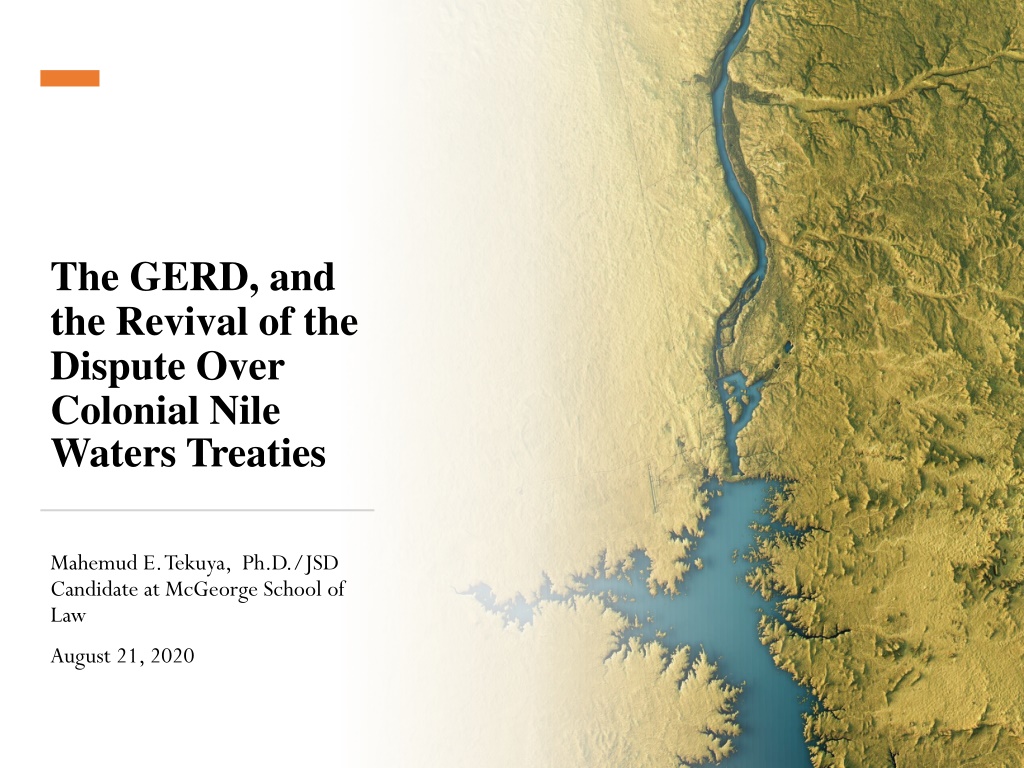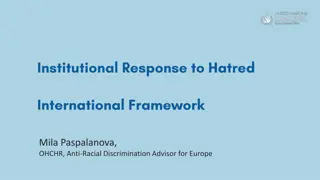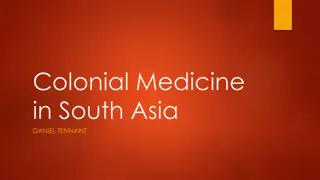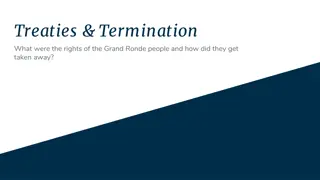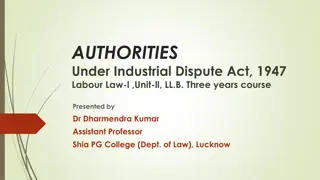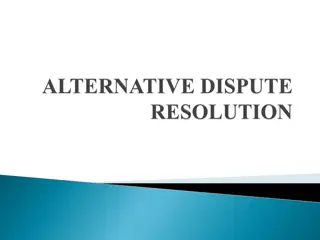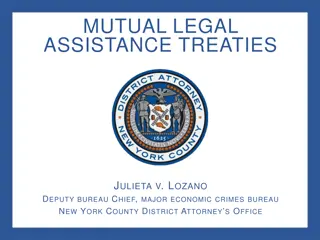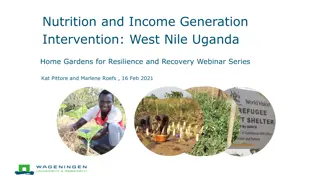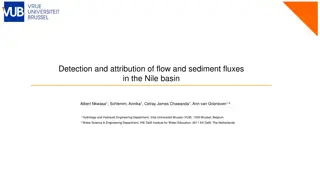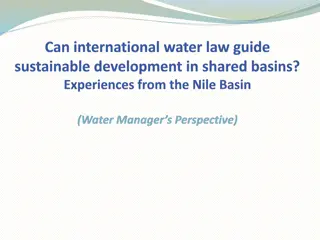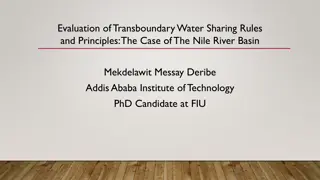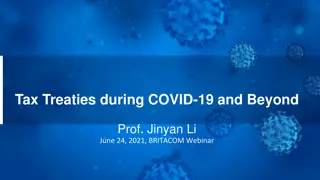The GERD Dispute and Colonial Nile Treaties
The article delves into the revival of the dispute over Colonial Nile Waters Treaties amidst negotiations on the Grand Ethiopian Renaissance Dam (GERD). It explores historical treaties, recent studies, and proposals to unlock the impasse. The methodology involves evaluative legal research to analyze the implications of the Colonial Nile Waters on GERD negotiations.
Download Presentation

Please find below an Image/Link to download the presentation.
The content on the website is provided AS IS for your information and personal use only. It may not be sold, licensed, or shared on other websites without obtaining consent from the author.If you encounter any issues during the download, it is possible that the publisher has removed the file from their server.
You are allowed to download the files provided on this website for personal or commercial use, subject to the condition that they are used lawfully. All files are the property of their respective owners.
The content on the website is provided AS IS for your information and personal use only. It may not be sold, licensed, or shared on other websites without obtaining consent from the author.
E N D
Presentation Transcript
The GERD, and the Revival of the Dispute Over Colonial Nile Waters Treaties Mahemud E. Tekuya, Ph.D./JSD Candidate at McGeorge School of Law August 21, 2020
Outline 1. Introduction 2. Background: Dispute Over the Nile Colonial Treaties A. The Nile Colonial Treaties B. Cooperative Framework Agreement: Solidifying the Disputes C. The Declaration of Principles: A Symptomatic Treatment? 3. Post DoP negotiations, and the Revival of Dispute Over Colonial Treaties A. The Two Studies on the GERD B. Egypt s proposal for the Filling and Operation of the GERD C. Washington Process and the Letters to the UNSC 4. Way forward: Towards Taming the Elephant in the Room
1. Introduction The Nile is made up of several tributaries. Three tributaries, the Blue Nile, Sobat (Baro) River and the Atbara (Tekeze and Angereb) River, originate in Ethiopia and contribute 86 % of the Nile waters. The other main tributary, the White Nile, originates in Lake Victoria and shared among Tanzania, Rwanda, Burundi, Kenya, Uganda, and the Democratic Republic of Congo, contributes the rest of the Nile flow. Generally, eleven countries share the Nile River
Objectives General objective To examine the implications of the Colonial Nile Waters (CNWT) on the GERD negotiations Specific Objectives To discuss the dispute over the CNWT To show how the dispute over the CNWT revived in (1) the GERD s impact studies (2) the Washington process and letters to UNSC To Explore possible alternatives for unlocking the dispute
Methodology Research paradigm It is a doctrinal research Evaluative legal research model is used to scrutinize - the salient features, -and ramifications the CNWT and the DoP on the GERD negotiation Sources of Data: Both primary sources (international agreements, treaties, CIL, and DoPs) and Secondary sources (literatures, journals, books) have been used. Method of data analysis: A qualitative method of data analysis i.e. the narrative and content analysis of both primary data and secondary sources have been undertaken
2. Background: Dispute over the CNWT A. The CNWT Several bilateral treaties, but the 1902, 1929 and 1959 treaties are the most dispute treaties 1. 1902 Anglo-Ethiopian Treaty It is a bilateral treaty concluded to determine the boundary between Ethiopia and Sudan Article III is about the Nile where Ethiopia undertook not to construct or allow to be constructed any work that would arrest the flow of the Nile without prior authorization from UK (Sudan) Source of dispute between Ethiopia vs Egypt and Sudan Egypt and Sudan consider themselves as successors of this agreement and so claimed that Ethiopia must get their consents to build any project in the Nile
Con. Ethiopia rejects this, claiming that the treaty was not ratified and that the meaning of the word arrest both in the Amharic and English versions does not preclude Ethiopia from using the waters 2. 1929 Anglo-Egyptian Treaty Britain, representing Sudan and its East African colonies (Kenya, Uganda, and Tanganyika). So called historic and natural rights of Egypt (48 BCM) & Sudan (4 BCM for Sudan) (52 BCM) Veto power, explicitly granting Egyptian authorities a right to preempt any changes in the status quo
Con. Asource of dispute Egypt vs. Kenya, Uganda, and Tanzania They invoked the clean State (Nyerere doctrine) doctrine and argued that had no role in conclusion, so should not be bound by it. Egypt claims it is binding based on territorial and boundary treaties exception. African states boundaries were determined by colonizers. Like boundaries, this treaty survives the treaty survives decolonization and bound former British East African colonies. 3. 1959 Nile Water Treaty Allocated the net benefit (32 BCM) generated HAD Sudan 18 BCM= (14.5 BCM + 4 BCM) Egypt 55.5 BCM =(7.5 BCM+ 48 BCM) 1O BCM for evaporation
Cont. But Egypt invokes established right , historical use or existing use and right principles and claims that it is legally entitled to the water share allocated in this agreement. Upstream States vehemently rejected this claim and called for a basin- wide treaty. B. Cooperative Framework Agreement: Solidifying the Disputes Started in the early 1990s and formalized in the adaption of the Nile Basin Cooperative Framework Project (Project D3) in 1995. All Basin States at the time, except Eritrea, negotiated for about 15 years (13 in NBI, but not correct) During the negotiations, the fate of the CNWT was subjects of the controversy
Cont. Upstream States argued that the CFA should replace and supersede over the CNWT Downstream States insisted that the CFA must explicitly recognize the CNWR so they would bind all Nile Basin States Non-legal and elusive concept called, water Security, came to reconcile the controversy. But they could not agree on 14 (b) Upstream countries 14(b) an obligation not to significantly affect the water security of any other Nile Basin State Egypt and Sudan wanted the language to be not to adversely affect the water security and current uses (60 BCM) and rights (18.5 BCM) of any other Nile Basin State Unequivocal recognition of CNWT (Egypt and Sudan walked away)
C. The Declaration of Principles: A Symptomatic Treatment? In April 2011, after signing the CFA, Ethiopia started constructing the GERD. Egypt and Sudan opposed the dam alleging that it would violate the CNWT. Considering the enormous advantages it would get from the dam including, regular flow of water (increase irrigation capacity), flood control, reduction of evaporation, enhancing production of electric and cheaper electricity, Sudan supports the dam in 2012. Gradually, after painstaking negotiations, Egypt also recognized the importance of the dam and the three States signed an agreement of the DoP on the GERD on March 23, 2015.
Cont. The DoP is a unique addition in codifying equitable and reasonable utilization, and of the no significant harm , as the governing rubric of the Nile Basin. But one of the problems of this document is that a symptomatic treatment and does not resolve the dispute over CNWT. Salman argues it abrogate the CNWT, but that is not the case. Tacit abrogation requires two conditions (1) same subject matter and (2) incompatible 1. It is not a treat, but even if it is, the DoP (framework for GERD) and CNWT (the whole Nile and veto) govern different subject matters. 2. It is a special one that can go along with the CNWT So, it does not abrogate the CNWT, and hence does not bring about de-jure change in the status quo. Rather, it creates the opportunity to maintain the CNWT.
3 3. . Post DoP negotiations, and the Revival of the Dispute Over Colonial Treaties A. Two studies recommended by IPoE Before the adoption of the DoP, the three States established IPoE The IPoE two studies: a transboundary impact study and a hydrological modeling study. The studies would be conducted under the supervision of the Tripartite National Committee (TNC), and the TNC hired two French firms. Egypt says baseline data to determine the impact should be its current use of the Nile waters (61 BCM). Tried also to exclude Sudan. Sudan demanded the 1959 Nile Treaty water allocation serve as the baseline Ethiopia rejects both, and propose National Independent Scientific Research Group (NISRG) to study scenarios for filling and annual operating the GERD
Cont. B. Egypt s proposal I. Ethiopia should fill the GERD slowly while releasing 40 BCM of water every year II. Egypt should have surplus water in lake Nasser (HAD must be 165 meters above sea level) Egypt can use the water as it wishes and claim more water from the GERD GERD non-functional (second reservoir for Egypt) III. Ethiopia should get approvals from Egypt at various stages of the filling and operation of the dam CNT and veto to Egypt. IV. Ethiopia should release the entire flow of the Nile waters after the filling of the GERD CNT, and will foreclose Ethiopia s existing and future right to use V. Egypt should open office in GERD site Sovereignty and again veto
Cont. C. Washington Process and the Letters to the UNSC Disagreed in every legal aspect. But two main sticking points. 1. Three Drought mitigations (drought 37, Prolonged drought 39 and prolonged dry years 40). Release the flow Prohibits Ethiopia from using tributaries and impose the 1959 Treaty on Ethiopia. Additional water from the GERD Presupposes that Ethiopia does not have a share from the Nile, Ethiopia is delivering below their share in 1959 Treaty, and so must pay it back. There is no water sharing arrangement in the Nile case, so inappropriate 2. Compulsory dispute resolution is inappropriate because a. DoP requires dispute to be resolved through negotiations, conciliations and mediations b. Kills the CFA. If they need binding dispute resolution, they should go to CFA
Cont. In its letter to UNSC, Egypt dined it is not trying to impose any colonial treaties on Ethiopia. But, ironically it invoked the 1902 Anglo-Ethiopian Treaty, trying to benefit from its colonial legacy. It also called upon Ethiopia to respect the current and existing uses . This is worst than imposing the 1959 Treaty because Egypt is currently using 61 BCM, and Sudan can t use its share under the treaty. Harm to the existing use is allowed under international law. So, while using its equitable share, Ethiopia can cause significant harm to the current use. What is prohibited is exceeding from equitable share.
5. The Way forward: Towards Taming the Elephant in the Room Now they are undertaking the tripartite negotiations through the AU. For the negotiations to move forward, the implications of the CNWT must be dispensed with. a. AU should help the three States to create a positive bargaining zone by (1) restricting the scope of the ongoing talks only on the filling and annual operation of the GERD, and (2) encouraging the States resort to the CFA for water allocation, dispute resolution and long-term operation of the GERD. b. No recognition of CNT, no water allocation, no prohibition of equitable use above GERD, and no association with HAD c. Equitable filling considering all factors (not potential impact) 4-7 years d. Amendment, review and revocation clause Otherwise, ANY GERD Treaty will be a tool for perpetuating of the CNT
